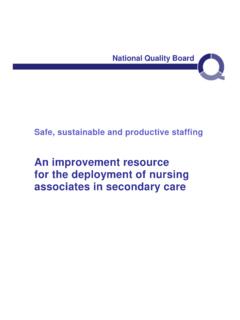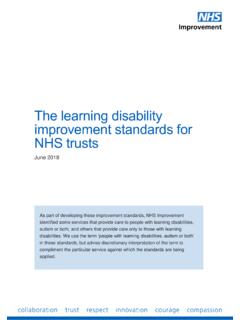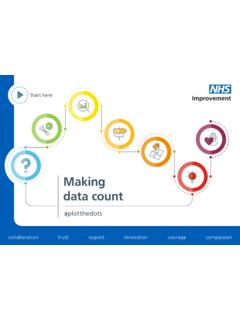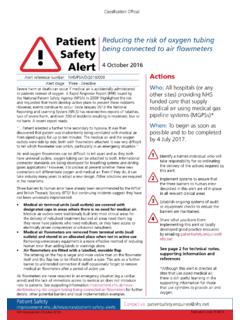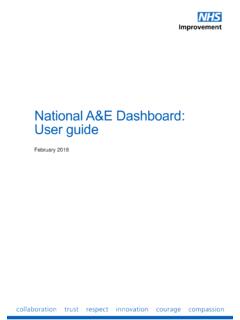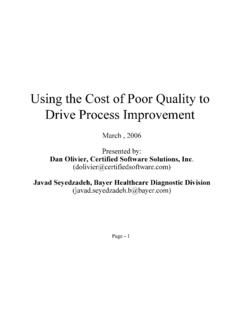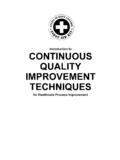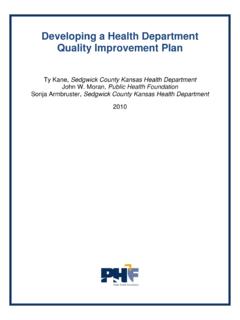Transcription of Online library of Quality, Service Improvement and ...
1 Online library of quality , Service Improvement and Redesign tools measurement for Improvement . an overview collaboration trust respect innovation courage compassion measurement for Improvement : an overview What is it? measurement for Improvement is designed to underpin Service Improvement it promotes an approach of collecting and analysing a sufficient amount of quantitative data to help you check whether a Service Improvement is working and, if not, to enable you to learn how to adapt your approach. It does not seek to prove or disprove whether clinical interventions work, it seeks to determine how we make evidence-based practice work and whether any changes made were an Improvement . The tools in this section help organisations, teams and individuals understand the importance of measurement for Improvement in enabling Service Improvement from the outset through to the completion of the Improvement project.
2 These tools will help you to use data to identify areas for Improvement and, when used in conjunction with the other tools in this handbook (mapping the process, provocation to help solve problems, Pareto, etc.), will support continuous Service Improvement . When to use it Clear, unambiguous and relevant measures should form the foundation of any Improvement work. It is important to ensure that you measure the right things in order to determine if an Improvement has been made. Otherwise you may find that your Improvement actions are wasted or might make things worse without you even realising it. If measures are unreliable then people can challenge any actions they oppose and delay implementation until trustworthy data is obtained and information reported. The tools in this section are particularly useful in ensuring that you make consistent decisions when working with teams.
3 Decisions will be based on fact, using data, which will hopefully complement gut feelings' rather than assumptions. How to use it Key things to remember when starting to measure for the purpose of Improvement include: Seek usefulness and not perfection measurement should focus on speeding improvements up and not slowing things down. Measure just enough to get to the next step keep measures simple and only collect the data needed. The goal is Improvement and not the measurement system. Make measurement part of the daily routine use collection systems and reporting mechanisms that already exist. Make sure people understand why they are collecting data to ensure engagement. If you encounter resistance, try to explain why you are doing what you are doing in terms of evidence base, increasing quality and safety and ultimately the patient experience. quality , Service Improvement and Redesign Tools: measurement for Improvement : an overview The specific detail of how to use each of the tools can be found in the relevant sub sections.
4 The tools available to support measurement for Improvement are: A model for measuring quality care (structure, process, outcome and balancing measures). Seven steps to measurement for Improvement including the measurement checklist Managing variation Run charts Statistical process control (SPC). Modelling and simulation Performance management Balanced scorecard Driver diagrams Plan, Do, Study, Act (PDSA) cycles and the model for Improvement What next? Look at the tools above if you are about to embark on Service Improvement or use them for your current Service Improvement projects to determine whether the measures are appropriate. Look at the way the information is presented is it in a format that is easy to interpret and demonstrates whether the change made has had an impact that was ultimately an Improvement ? Is the reason for data collection clear to the team? Can any of the tools above help to improve this?
5 Background There are three main reasons why we measure: research, accountability and Improvement (Solberg, 1997). Understanding why you are measuring is important as it influences what data you need to collect and how often you need to collect and review it. References Solberg, LI, Mosser, G and McDonald,S (1997) The three faces of performance measurement : Improvement , accountability and research, The Joint Commission Journal on quality Improvement , Mar: 23(3): 135-47. Written by the ACT Academy for their quality , Service Improvement and Redesign suite of programmes. Contact.

